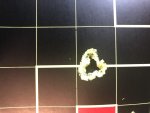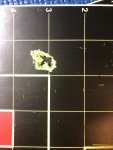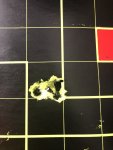Not trying to be harsh here, but fiddling with protrusion on a pin is the last thing people should be doing when they experience light strikes.
I've had over 2 dozen guns of various actions show up at my shop with "light strike problems, they keep getting worse no matter how much pin protrusion I give it"
Here's what to check and why screwing with a pin protrusion is a bad idea:
Step 1: Measure your pin protrusion. If it is anywhere in 0.030-0.050" leave it alone. There is PLENTY. You only need about 0.025" for extremely reliable ignition IF you have everything else right.
Step 2: Check your ammo to see if you have any primers that aren't seated to the base of the pocket. Typically the issues brought to us are from folks that use hand primers and somewhere in the marathon batch of priming brass while watching TV their hand got tired and some primers slipped through not quite fully seated.
The reason Step 2 is critical is because if the pin has proper protrusion and the primer isn't set properly the energy from the strike is robbed to push the primer to the base of the cup.
"I checked this, all the duds were seated all the way"
Correct, they are seated all the way because the firing pin impact finished the seating process.
It also didn't have enough strike left to set off the primer.
Had they been checked before being a dud it is highly likely that it would be discovered that they were just a little bit proud. Even dead flush isn't enough. Modern brass has relatively tight constraints for primer pocket depth and that sets up so that the primers (arguably one of the most consistent parts of modern ammo) is going to be a couple thousandths sub flush.
Step 3: After having some duds, go back and check the rest of that batch and see if you find any others that are not sub flush. Sometimes it's just enough that they go off; sometimes not.
Step 4: Take anything you find that is a proud primer and separate into 2 piles, split it in half. Take half and reseat the primers in a press so that they're properly seated in the case. Take those half and the half that is suspect and go to the range. Note which is which and shoot them.
If the ones you reseated go off (mind you, once a poorly seated primer is struck it isn't likely to go off on a second time hitting it) and the ones that are still suspect have fail to fires you found the culprit.
I've been around and around on this with several prototype actions that I've had from companies where I worked to help develop from a prototype to a production model.
I stopped hand priming because of this.
So, I didn't yet address why pin protrusion is the wrong avenue to mess with.
When the bolt is in battery in the action the bolt face is the line of reference.
It can be assumed that the primer is sitting against that face. We've discussed that a properly seated primer should be slightly subflush so therefore this is a conservative estimate of impact energy. Nevertheless it makes the discussion easier to digest if we ignore that complication for the time being.
A spring has a given amount of potential energy in it while assembled in the gun.
It has PE when it is decocked because there is preload in it.
The PE is defined as 1/2 * mass (spring and pin together) * compression distance ^2 * springrate
compression distance is defined as "X"
PE = 1/2 * X^2 * k
PE when it's assembled and uncocked is PE0
PE when it's cocked and ready to fire is PE1
PE1-PE0 = PE of the system to impart on a primer.
Ignoring outside losses and inefficiencies (I'm going to assume energy is conserved, which we know it isn't but it works for this discussion)
The kinetic energy at the instant the pin crosses the bolt face plane cannot be larger than PE1-PE0 aka PEstrike
Now:
The cocking piece and cocking cams have a given lift imparted to the firing pin no matter what happens.
In a Bighorn this value is approximately 0.2"
In a Nucleus it's very similar.
In a Remington 700 it's closer to 0.28"
If the pin is adjusted further out at decocking then the amount of distance that the pin is retracted behind the bolt face during cocking is reduced.
Remember, the cocking lift is a fixed value and cannot change. Therefore if the pin used to be pulled from 0.05" forward of the bolt face and it's retracted by 0.2" it is now 0.15" behind the bolt face.
The potential energy stored is actually higher than when the pin is fully decocked but that's useless storage to set off the primer, you can't get it out of the system because the primer is strong enough to withstand regular pin forces while decocked. Try it sometime. Put a piece of primed brass in the chamber and hold the trigger while closing the bolt slowly. Open it back up.
There may be a tiny witness mark on the primer but the primer didn't go off nor did it dent the primer.
So, this is important because if we cannot get that energy back into the pin tip during impact we're never going to setoff the primer.
Back to the energy of the spring while it's cocked.
At full cock on a 0.05" pin protrustion the system has a given amount of PE
If we pull that pin back by 0.02" to a protrusion value of 0.03" then we have given 0.02" more travel on the pin before it crosses the reference plane to hit the primer.
Since we had 0.2" to begin with total, less 0.05" protrusion
We had 0.15" lift useful.
Now we have 0.17" lift useful.
The mass and springrate hasn't changed, just the X value.
so PE15 = 1/2*k*(0.15"+preload)^2
PE17 = 1/2*k*(0.17"+preload)^2
In a bighorn there's about 1" of preload in the spring
when we look at a ratio of the values PE17/PE15 everything cancels except the X^2 values
1.17^2/1.15^2
Doesn't look like much but it's about 3.5% difference in energy available to start with.
A more extreme example would be an action presented to us by someone who was tired of dealing with "it must be the Jewell trigger" from his last gunsmith. The guy had charged him for 3 triggers total and every time he got it back he had a brand new trigger installed and more firing pin protrustion.
It was so bad that the thing wouldn't set off primers at all and then got to the point that it would have extremely hard closing on teh bolt on factory ammo.
When I got it the pin was unable to retract through the bolt face any longer. It was protruding nearly 0.015" just in a cocked condition. That explained the heavy bolt closing. As the bolt was being closed it was cocking the action off the trigger...
I adjusted the firing pin protrusion back to 0.032" and it set off every primer we threw at it, including the notoriously hard machine gun primers from CCI the #41's
So in a less severe but similar example that came in from an adjustable pin action the customer had extended the pin out to 0.07" travel and "it keeps getting worse, I think I have a defective action"
0.2" lift with a target of 0.035" protrusion is 0.165" delta
At 0.07" protrusion they had 0.13" lift available
0.13^2/0.165^2 = 0.621 or 62.1% of the strike energy that it should have had. It was not going off 90% of the time, I was amazed that anything went bang to be honest.
When we reset it back to 0.035" of protrusion it went off 50 times in a row with primed brass at the shop.
Long story short, the VAST majority of the time adding firing pin protrusion is not the answer. There are other much simpler reasons for light strikes.
In an action that's brand new from the factory it's possible but I know that ARC has a jig setup to set the pin protrusion from the start and they have a design that cannot come loose and wiggle further out.
Some designs can do that and I've seen it where over thousands of cycles the locking screws work loose and the pin wanders forward. The light strikes are inconsequential at first but then they get to a critical point and all of the sudden it seems to be endless light strikes and ultimately completely failure of the system.
Not enough protrusion is a possible failure as well but even back at 0.015" I watched a bolt action that went off 47 times out of 50 rounds. The pin was an accidental setup part that was mixed in with good ones but even at 0.019" short of the design nominal it still went off a LOT... The customer discovered it when the weather turned cold and he got a lot more failures.
Replaced the pin, set it to 0.032" protrusion and it's been back for 2 more barrel replacements without a single reported failure since.








